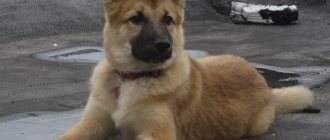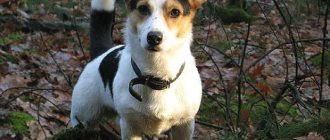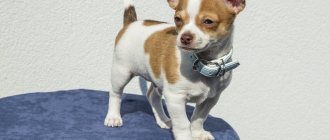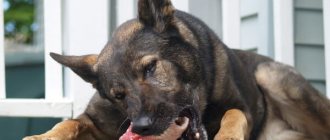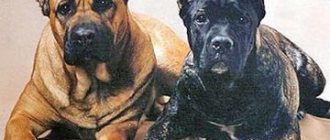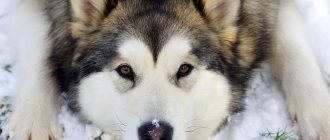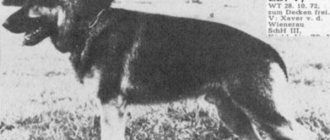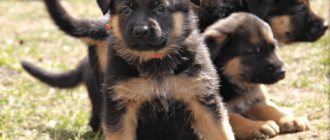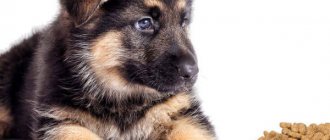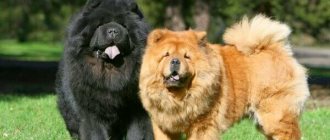Characteristics of breeds
The distinctive features of the Caucasian Shepherd are its intelligence, courage and independence. These are fearless animals, ready to fight even the most dangerous opponents.
Mixed Caucasian with German
The main feature of the “Germans” is considered to be their increased intelligence and intelligence. These are sensitive and courageous animals, with increased activity. They get along well with children and are very friendly to others.
The mixture of will, determination and independence of the Caucasians with the playfulness, intelligence and friendliness of the Germans resulted in an excellent mixed breed with a combination of the best qualities of the two breeds.
Nutrition
The Caucasian Shepherd breed is not demanding on its diet, but you need to know the nuances in feeding an adult animal. The frequency of meals depends on the time of year and the age of the dog. In winter, when kept outdoors, they are fed 2 times (morning, evening). In summer, evening meals can be eliminated by increasing morning meals. After the dog has eaten, the cup should be empty. If food remains, it is necessary to reconsider the diet and portion size. An approximate calculation of liquid food is 50 grams per kg of weight. Dry 15 g per kg body weight.
It is necessary to give solid food, pre-boiled trimmed bones. A lactating female has three meals a day. How well the feeding is organized can be determined visually. According to the condition of the coat, weight stability. The stomach is retracted or, on the contrary, saggy.
Mandatory presence on the menu:
- meat products:
- sea fish;
- all kinds of cereals, the dog will make its own choice which ones it likes best.
It is not recommended to overuse pasta and give fresh white bread.
Who are mestizos
By mestizos we mean offspring that are the result of crossing between several breeds. Most often, it surpasses its parents in characteristics. They may be less aggressive and more resilient.
Important! In most cases, mestizos are bred purposefully.
A purebred breed has characteristic habits, character traits and color. But their problem is susceptibility to genetic diseases. In contrast, mixed breeds are more resilient, but they have behavioral difficulties.
A lot of positive traits are manifested in the character of mestizos. They turn out to be friendly and good friends for children. But at the same time they retain excellent security qualities. Such a dog is sensitive to a person’s mood and will never let an enemy near its owner.
Mestizos are loyal and devoted friends
Why do you get a hybrid of a husky and a shepherd?
Crossbreeding is a method of obtaining crossbreeds that have good health, the absence of genetically inherited diseases, and advantages in appearance. If hybrids have been bred over several years, their appearance is officially documented, and sometimes they are registered as a new breed.
In the case of the German dog and the husky, scientists set themselves the task of obtaining a hybrid capable of working in harsh arctic conditions. The designer dog was supposed to not only transport cargo, but also participate in rescue and search operations during snow storms, blizzards and blizzards. American breeders were involved in crossing husky and shepherd breeds. They managed to breed a stately, handsome mestizo with high intelligence, capable of working in northern climates. Unfortunately, he is not as hardy as the Hasyata and does not obey his owner unquestioningly like a German dog, but his character and characteristics are used in modern life.
Advantages of mixed breeds over purebred dogs
Owners of Caucasian Shepherd and Shepherd mixes characterize this species only on the positive side. They become more obedient, friendly, and flexible in character than their parents.
Among the main advantages are:
- The shepherd dog mix is characterized by obedience and a calm nature.
- They get along well with cats and small dogs and love children very much.
- These are reliable and loyal friends for the owner.
- Such shepherd dogs are easy to train and can be trained.
- The pet adapts well to any weather conditions; outdoor living is considered the best option for it.
- Mestizos are not characterized by manifestations of hostility and aggression, which are partly present among Caucasians.
Important ! This species is not intended for keeping in an apartment. Mixed breeds turn out to be very large in size, so they feel most comfortable in enclosures outside, in a spacious area.
Keeping at home
In the apartment, the dog is given a separate, permanent place, to which the animal will be accustomed from childhood. Considering that the coat is thick, the lounger is placed away from heating radiators. Care must be taken to ensure there is sufficient light and no drafts.
The resting place should be organized taking into account the size of the animal. Mandatory presence of fabric bedding. It is cleaned and treated with disinfectants (approved for use) once every two months. Possibly more often as it gets dirty.
Caucasian Shepherd puppies in the meadow in summer
The dog's permanent place should not be near the kitchen or dining room. Near the refrigerator and in a walk-through area. The shepherd dog kept in the apartment is walked in the morning and evening.
What does a cross between a Caucasian Shepherd and a German look like?
A mixed breed of Caucasian and German Shepherd is a very beautiful dog with a powerful physique and a perceptive mind. Externally, the puppy will look like a Caucasian, but with age it will show features of crossed breeds.
The positive aspects of breeding a mixed breed of Caucasian Shepherd and Shepherd include:
- strong physique, with well-developed muscles;
- medium length tail;
- large head, slightly elongated nose;
- thick, long hair, thanks to which the pet can withstand outdoor conditions well;
- a variety of colors inherent in both Caucasians and Germans - most often the coat color characteristic of German shepherds predominates.
A cross between a Shepherd and a Caucasian Shepherd is very large. Such dogs can reach up to 70 centimeters at the withers.
Important ! If a mestizo's fur is wavy and there are white spots in the color, this indicates that crossing took place with another breed or mongrel. In this case, character traits may be unpredictable.
Appearance of the crossbreed
Types of Shepherd Dogs
Numerous peoples living in the Caucasus, according to centuries-old traditions, tamed Caucasian Shepherd Dogs.
Currently, there are several varieties in the world, depending on their habitat:
- Georgian type. Such Caucasians are massive, tall dogs with a slightly elongated body and long hair of a single gray color.
- Armenian type. These dogs, like individuals of the Georgian type, have long, monochromatic hair, but in size they are not so tall and massive.
- Dagestan type. Caucasian Shepherd Dogs of this variety are the largest. They have a square body and a variety of coat colors and lengths.
- Azerbaijani type.
The latter, in turn, are divided into 2 subspecies:
- mountainous (reminiscent of Georgian-type Caucasians);
- steppe (short-haired dogs of dark fawn and sometimes red color with a square body, long limbs and short hair).
Wolf dog character
From a mixture of Caucasian and German shepherd dogs, an amazing combination of all the positive character traits of both one and the other breed is obtained. They combine friendliness, courage and determination with activity and energy. The puppies turn out to be very playful and inquisitive. They are very attached to their owner. We are always ready to actively take part in joint games.
Character traits include:
- calmness and poise in any situation;
- firmness and perseverance;
- lightning-fast reaction in the event of any dangerous situation.
You can never say exactly what kind of character a mestizo will have when choosing a puppy. Experts are recommended to carefully study the habits of both parents.
Metis is an excellent guard
Nutrition
The offspring show sufficient activity already in the second month of life. Playful, active creatures require special attention in terms of feeding. Food is taken strictly at a certain time, in small portions. Thus, the baby’s digestive system is stimulated to function normally. The frequency of meals depends on age.
| Puppy age | Feeding frequency |
| 1-2 months | 5 times |
| 3 months | 4 times |
| 4-6 months | 3 times |
| From 7 months | 2 times a day |
If the owner's choice was to purchase ready-made food for the puppy, there will be no problems. Just follow the recommendations for use. But if the decision was in favor of homemade food, you need to know how to feed and what. For normal development, the pet must receive fats, carbohydrates, vitamins:
1. All types of meat that have undergone heat treatment, except fatty pork.
2. Poultry, both boiled and raw (without bones).
3. From six months, liver is added (kidneys, liver...).
4. Fermented milk products are given that promote the growth of bone mass and teeth (whey, kefir, cottage cheese).
5. From 3 months, boiled fish (without bones and scales) with vegetables is introduced.
6. Cereals will provide the puppy with carbohydrates: buckwheat, oatmeal, barley. Rice must be given in small portions and introduced gradually; it is “heavy” for digestion.
From 4 months, the puppy is given raw bones with leftover meat (except poultry). It's good for your teeth.
Working qualities and training
From birth, the German and Caucasian Shepherd breeds are characterized by watchdog and security skills. These dogs were used to herd livestock. They are very diligent and can stay in one area for a long time without changing location.
Outwardly it may seem that the mestizo is very calm, but this is deceptive. If danger appears on the horizon, he will react to it immediately. Thanks to these qualities, a mixed Caucasian with Germans is used for official purposes to organize search operations and protect objects and territory.
Important! Balanced and calm dogs are not empty-headed dogs. They calmly react to extraneous sounds and passing passers-by.
The dog will treat any stranger with caution, but will not show aggression for no reason. He will never attack without warning and will growl first.
The training process should begin as early as possible. Already as puppies, mixed-breed dogs begin to learn commands. It is important that the training process is led by a person who has earned the dog’s trust and become its leader. Training should be carried out in two stages. First, the puppy is trained, and then the acquired skills are consolidated in an adult dog.
Security qualities
In the past, both Caucasian and German Shepherds were herding dogs, so they naturally have guarding and protective functions. A puppy mixed from these two breeds will have innate guard instincts, and he will cope well with the role of guarding the house and the territory entrusted to him. These huge animals skillfully choose an observation point for themselves, from which they can see all the surroundings and can stay there for hours without even changing their position. But the dog’s calm and tranquility is deceptive; it is always on the alert and ready to react with lightning speed to any threat.
The hybrid will not bark for no reason; it calmly reacts to passing cars, extraneous sounds and people passing by. The dog, in whose veins the blood of Caucasians and Germans flows, is able to adequately assess the situation and make decisions independently. They are distrustful of strangers, but they do not have the aggression and anger inherent in representatives of the Caucasian breed. The half-breed will not immediately rush at the stranger, but will warn him with a threatening growl that he should not come closer.
The crossbreed is distinguished by its flexible character, easy to train, and friendliness to other animals.
Unlike the same Caucasian Shepherd Dogs, the hybrid is loyal to other pets. Mixed breeds perceive small defenseless animals, such as cats or toy dogs, as objects that need to be protected. The picture looks quite cute when an impressively sized dog allows a tiny kitten to pull its tail or climb onto its wide back. But mixed breeds do not get along with other large dogs and will prove their superiority in a fight with them. Peaceful coexistence of two such dogs in one home is only possible if they were raised together from a young age.
A mixture of these two breeds is highly trainable; they do not have the stubbornness and willfulness of the proud Caucasian Shepherd Dogs. Mestizos are obedient and disciplined, quickly remember commands and meekly carry out all the orders of the owner.
Subtleties of feeding and care
Mixed breeds do not require special living conditions, but owners need to observe certain nuances in caring for such a pet. Since shepherd mixes are large in size, it is recommended to keep them in private houses with large plots. It is best to equip an enclosure for your dog. Metis needs daily walks, active games, and running.
One of the distinguishing characteristics of mestizos is good health. But you still need to take your pet to the veterinarian for a preventive examination every year.
Particular attention should be paid to nutrition. It is necessary to exclude from the diet foods that the parents of the mestizo do not eat. They will be poorly absorbed due to genetic predisposition. It is not recommended to give your dog:
- any smoked meats;
- flour products;
- sweet;
- food with spices.
Since mixed breeds have long and thick hair, it must be combed with a stiff brush at least twice a week. During the molting period, it is recommended to carry out the procedure daily.
Crossing a Caucasian with a German gives an excellent result in the form of a good-natured, but reliable and loyal mestizo. This will be a real guard and friend who will protect the owner and have fun with him.
join the discussion
Share with your friends
The expression “a dog is man’s best friend” has already set teeth on edge, but for a long time this phrase has carried a grain of truth. It is dogs that are capable of sincere loyalty and devotion. And it’s not at all necessary that your best friend should be an expensive purebred puppy, because you don’t buy friends. A mixed mongrel with a shepherd can become an excellent companion and friend for the whole family.
Differences up to one month of age
If anyone who has ever encountered pedigree dogs of this group can already distinguish a shepherd from a mongrel at the age of 5-6 months, then not everyone will be able to make the right choice at the age of 3-4 weeks. What should you pay attention to at such a tender age?
Mom and Dad
Never buy a puppy without making sure that its parents correspond to the breed characteristics of the German Shepherd. The best evidence in this case is the correct documents for the parents and the children themselves.
To reassure yourself, you should call the club and find out if mom and dad are registered there.
Attention! The club may refuse permission to breed if one of the parents has hip dysplasia.
This is a hereditary disease (genetic predisposition), the symptoms of which may appear only at 6-12 months of age: lameness, increased fatigue, joint pain, unsteadiness of gait, X-shaped stance of the hind limbs.
Hip dysplasia is a real scourge of large breed dogs (which includes the German Shepherd). Treatment is long, painful and not always effective.
Brand
Confirmation of documents is a mark on the inside of the hind paw of both the parents and the puppy itself. Plus the metric, of course.
The stamped mark and the information about it in the metric must match!
If the baby does not have a mark, then, most likely, the mating was “left-handed”; the club did not give permission for it. Such a puppy can be purchased as a pet - this is a real shepherd dog, which has received breed characteristics from its parents, both in appearance and psyche, but the path to the ring will be closed to it.
Advantages and disadvantages
Perhaps, of all the varieties of mongrels, it is the cross with a shepherd that is most common. Such dogs can be found at a dog park on a leash with their owner, or they can also be seen in a stray dog pack. According to the description, the dog still looks more like an unknown parent than a shepherd. Compared to a purebred pet, mixed breeds have their advantages:
- Shepherd and unknown breed puppies turn out stronger and healthier;
- mestizos are resistant to genetic diseases;
- such puppies have stronger immunity;
- their intelligence begins to manifest earlier;
- the cost of non-purebred puppies is noticeably lower;
- Mestizos are less likely to need special, expensive food.
Before getting a mixed-breed puppy, it is important to familiarize yourself with its disadvantages:
- it is unknown what size the pet will grow;
- non-purebred animals do not have documents or pedigree;
- cannot participate in the exhibition;
- You cannot know in advance what kind of character a dog will grow up to have.
How to choose the dog of your dreams?
The catalog presents mixed-breed puppies as a gift in Moscow, which are given by volunteers from shelters or by their owners into good hands. There are also adult dogs here with already formed character and temperament. The selection filter allows you to select an animal according to the necessary parameters: gender, size, purpose (for family, hunting, protection), coat length.
Thousands of homeless animals are looking for a new home. Check out the advertisements, on each you will find a photo, a description of the dog’s fate and contact information for the temporary owner. Choose your pet with your heart, and when you find “yours,” contact the author of the ad.
Differences
If the owner definitely wants to have a purebred puppy, then he should be careful when choosing a breeder. Not all of them are decent; under the guise of a purebred puppy, they can sell you a mixed breed of shepherd and mongrel. You can distinguish a purebred shepherd from a mixed breed by the following characteristics.
- Already at 2 months, a purebred shepherd cub is larger than its non-purebred counterparts. It has more powerful and robust paws with strong joints and no curvature.
- You can notice a distinct furrow on the mongrel’s forehead, which is not found on the shepherd dog.
- A purebred dog always has a scissor bite, but a mongrel can have any bite.
- As a shepherd dog gets older, its ears become hard and stand up on its head; mixed breed dogs have ears that remain hanging down.
- A mongrel/shepherd mix has a barrel chest, while a purebred puppy has a wide and massive chest.
Height and weight by month
The initial stage of the life of such a shepherd dog begins from the moment of its birth until 7 weeks. When born, the weight of puppies is usually 0.6-0.8 kg. If the newly born kitten weighs less than 600 g, it is unlikely to grow into a large dog.
Too large a puppy also does not guarantee ideal health. Before buying such a pet, whose weight at birth was more than 800 g, you need to visit a veterinarian and ask him about whether the animal has any congenital disease.
In the first month of life, namely from 15 to 20 days, dogs need special treatment from the owner. This is a serious stage in the development of a Caucasian. During this period, his auditory and visual perception of the world develops. The puppies begin to explore the objects around them. At this age they can already walk.
When little Caucasians turn 2 months old, they begin to gain 400-420 g daily. As a result, the weight of two-month-old Caucasians averages from 13 to 19.6 kg.
At 3 months old, little Caucasians are still a little clumsy and clumsy. Gradually, their limbs and neck begin to “stretch.” The body takes on an oval structure. The head grows in size, as does the chest. During this time period, young individuals externally resemble bear cubs.
Three-month-old Caucasians are still growing rapidly, maturing and gaining weight. Every day they gain 200-400 g. As a result, a pet at this age should weigh from 18 to 32 kg. At the withers, the height of girls is usually 43-46 cm, and that of boys is 45-49 cm.
When babies turn 4 months old, their weight should average 25-60 kg. Five-month-old dogs of the Caucasian breed have a maximum weight of 64 kg, and the smallest - 35 kg. At this age, animals acquire their natural color. In adolescents, molars grow rapidly and ears rise. At this stage, the young dog looks almost the same as the adult.
Upon reaching 6 months, young shepherd dogs usually weigh 40-94 kg. The height of individuals at the withers for males is 63-68 cm, and for girls - 59-63 cm. It is at this moment that females may experience their first heat. However, experts do not recommend breeding dogs of this type at this age. It is better to do this no earlier than when Caucasians turn 2 years old.
After 6 months, such dogs stop growing as rapidly as before. In 4 weeks they can gain approximately 1700 to 5160 g. Typically, a 7-month-old Caucasian weighs 41.7-99 kg.
Eight-month-old animals weigh from 43.4 to 104.4 kg. The difference between the largest and smallest weights is largely due to the genes of the parents, the state of health of the individual, as well as the correctness of its maintenance.
Nine-month-old purebred dogs typically weigh between 44.8 and 109.5 kg. These are already almost fully formed individuals. True, they will still continue to grow, although not so rapidly.
Many of the representatives of this breed grow until they are 10 months old. Having reached the specified age, such a dog looks like an ordinary adult. A 10-month-old male will weigh between 46.2 and 114.6 kg.
From 6 months to a year, the mass of the described animals increases by a third. For females, the normal weight is 40-115 kg, and for males - 50-125 kg. The height at the withers for males is usually 68-78 cm, and for females - 64-72 cm.
If you have purchased a puppy of the breed described, then you should monitor how it grows and develops. Height and weight values most often indicate the health status of pets. For example, slow growth or stopping may indicate the presence of certain diseases or deficiencies in the diet. It is better to keep on hand a detailed table that shows all the necessary indicators for a growing dog.
| Month (animal age) | How much does a male dog weigh? | How much does a bitch weigh | Height at the withers of a male dog (in centimeters) | Height parameter (measured at the withers) |
| 1 | 4000-6800 g | 2500-4500 g | 24-26 | 23-25 |
| 2 | 13000-19600 g | 11500-18000 g | 34-37,5 | 33-35,5 |
| 3 | 18000-32000 g | 16500-30000 g | 45-49 | 43-46 |
| 4 | 25000-60000 g | 22000-50000 g | 51-55,5 | 48,5-51,5 |
| 5 | 35000-64000 g | 32000-60000 g | 57-62,5 | 54-57 |
| 6 | 40000-94000 g | 35000-92000 g | 63-68 | 59-63 |
| 7 | 41700-99000 g | 35700-96200 g | 64-70 | 60-65 |
| 8 | 43400-104400 g | 36500-100600 g | 65-72 | 61-67 |
| 9 | 44800-109500 g | 37200-104800 g | 66-74 | 62-69 |
| 10 | 46200-114600 g | 38000-109000 g | 66,5-75 | 63-70 |
| 11 | 47600-125000 g | 38600-113200 g | 67,5-76 | 63,5-71 |
| 12 | 50000-125000 g | 40000-115000 g | 68-78 | 64-72 |
Character
Thanks to a genetic connection with shepherd dogs, mixed-breed puppies have high intelligence and therefore respond well to training. Such a dog will easily carry out even the most complex commands. She quickly becomes attached to her owner and is characterized by loyalty and complaisance. This puppy is perfect for keeping in a family with children.
In general, these are active and mobile dogs that love long walks, trips to nature, and swimming. Such dogs have good protective qualities; they are not aggressive, but by barking they can warn the owner about the approach of a stranger. Mixed breeds get along well with other animals, these can be dogs, cats, and other pets.
From shepherd dogs, mongrels also adopted sincere devotion to their owner. There are many cases where mestizos remained faithful to their man to the last and waited for him in one place. With proper upbringing, a mestizo can turn out to be a four-legged friend, not inferior in its qualities to a purebred relative.
Characteristic differences in growing puppies
If you still decide to buy an “unconfirmed” puppy, then pay close attention to its appearance so as not to repent later. A dog is purchased for more than one year! If you want to get a faithful friend, whose meaning of life is contained in the motto: “Serve and protect!”, then you need to remember the main signs by which you can distinguish a shepherd from a mongrel.
Do not purchase a puppy before he is 3-4 weeks old!
Until this age, it is difficult even for a specialist to distinguish a HO (German Shepherd) from a large mongrel. By the age of one month, the baby develops characteristics characteristic of a purebred shepherd dog - generic differences.
Eyes
The BUT puppy's eyes are set slightly askew, have an almond-shaped cut , and when the baby turns his head, trying to look at a new object for him, the pure white white of the eyeball . Because of this eye structure, the shepherd's gaze is often compared to a human's. Such eyes are found in the “German” and in the East European Shepherd puppy.
The rainbow arch is from dark yellow to deep brown. Up to 2 months it can be blue or light blue. The look is lively, expressive, curious and playful.
Mongrel puppies have round, slightly protruding eyes. When turning the head, the protein stands out weakly, the color is yellowish or with dark spots. The gaze may be lively and curious, but it cannot be compared with a human one.
Clearly standing ears at 1.5-2 months old in a puppy is what distinguishes a mongrel from a shepherd dog 100%! A German Shepherd's ears don't stand up at this age! Large and soft ears of shepherd dogs appear by 6-8 months.
Who are the mestizos?
Pit bulls, in fact, are themselves the result of interbreeding, since their ancestors, called bull and terriers, were obtained as a result of mixing the blood of Old English bulldogs and terriers.
Probably, later, when the ancestors of the modern pit bull terrier came to America, where the final formation of the breed took place, their owners also resorted to interbreeding in order to improve the quality of the offspring.
At the present time, when some professional breeders and dog handlers support the ideas of lovers of designer breeds, while others sharply object to the deliberate breeding of mixed breeds, people have developed an ambiguous attitude towards pit bull crosses.
Many breeders of purebred dogs believe that mixed breeds do not always inherit the best qualities of the two original breeds and that the results of such experiments can often be unpredictable.
Other experts believe that by adding blood from other breeds to pit bulls, it will be possible not only to get rid of the innate animal aggression inherent in this breed, but also to make pit bulls suitable, for example, for guard duty or for working as bodyguard dogs.
Who are mestizos and how do they differ from purebred dogs?
Mestizos are the “fruits” of intraspecific crossing, in which both purebred and outbred animals can participate. Any mestizo is essentially a mongrel, and is by no means a new breed, as experimenters would like to think.
Shepherd and Laika - similar in appearance, but very different in character
From the first experimental mating to recognition of the breed is a long-term, thorny and costly path that only a dedicated and patient dog handler with a base of theoretical knowledge and extensive practical experience can do. Creating a new breed involves several mandatory steps:
- obtaining stable offspring from generation to generation;
- consolidation of general desired characteristics in appearance and behavior;
- formation of a fairly extensive gene pool of healthy dogs with well-predictable prospects.
To consciously obtain mixed breeds of various breeds, you must at least be guided by Mendel’s three laws:
- law of uniformity of the first generation - offspring in the first generation inherits the characteristics of only one of the parents according to the principle of dominance;
- the law of segregation - in the offspring of the second generation, individuals appear with the phenotypes of the original parental forms and the offspring of the first generation;
- the law of independent combination (inheritance) of traits - among the descendants of the second generation, individuals with new (relative to the parent) combinations of traits appear in a certain ratio.
The potential of a mestizo can be very interesting; it is the owner’s task to reveal it
Shepherds and huskies
You need to understand that huskies (like shepherd dogs) are not one breed, but a rather large and diverse group of breeds, each of which has its own characteristics, and often its own working specialization. This must be realized before forming a specific parent pair out of them.
Features of Laikas
The concept of “husky” unites about a dozen officially recognized and about the same number of unrecognized breeds. They are medium to slightly larger than average Spitz-shaped dogs that live in cold climates and have aboriginal roots. The FCI classification places all of them in the fifth group - “Spitz and primitive type breeds”.
Most huskies are universal working dogs that can combine two or more “professions,” but most breeds are still focused on certain work functions:
- hunting;
- sledding;
- security - rarely;
- shepherds - even less often.
For crossing with huskies, breeds that are distinguished by pronounced service talents, good trainability, obedience, and also “wolf-like” appearance are usually used. The results of such cross-linking can be really interesting.
Distinctive qualities of shepherd dogs
In the FCI catalog, shepherd dogs are classified in the first group - “Shepherd and Cattle Dogs”. They are even more numerous and diverse than huskies: about forty breeds have received official recognition. At least twice as many as yet unrecognized shepherd dog breeds have emerged in various territories around the world. All of them have a herding background, and many remain professional shepherds today.
Modern shepherd dogs have received new canine specialties - they serve in the police and customs, protect people and property, become rescuers, guides, and companions. The natural potential of these dogs is very great, and their ability to learn is extremely high.
For what purposes are huskies and shepherds crossed?
Mixed-breed puppies can be born in different ways:
- accidental - dogs of different breeds are mated due to the owner’s oversight;
- irresponsibly experimental - according to the principle “I wonder what will come of it”;
- consciously - to obtain a working dog with improved qualities.
Often, ordinary large mongrels are sold under the guise of a husky-shepherd mix.
The first two options can be ignored: a normal breeder will not breed notorious mongrels without caring about their future fate. As for the third: within the framework of official cynology, where interbreed matings are prohibited, such experiments remain, as it were, illegal. But it is quite possible to understand the breeder’s natural desire to improve the degrading dog population:
- stabilize the nervous system;
- strengthen the immune system;
- increase endurance;
- improve the musculoskeletal system;
- consolidate working qualities and expand their range.
The purpose of crossing is to obtain a new large, hardy, active, intelligent and easy to train dog
Mongrel cross
The size, appearance and character of such a dog largely depend on who its second parent was.
Pit bull and mongrel mixes are rarely above average size. Most of these dogs have fairly short or medium-length hair, semi-erect or almost erect ears, and are predominantly black, red or white in color. There are also brindle mestizos, but the blue or isabella color of the coat of these dogs is very rare.
Among the character traits, it can be noted that crosses with mongrels are distinguished by endurance, mobility and energy. In most cases, they are loyal to people, even strangers, and love children.
However, they often get innate zoo aggression from pit bulls, which makes it difficult to keep them with other pets.
Of all the possible combinations of the blood of a pit bull and other dogs, it is mixed breeds with mongrels that are considered the most unpredictable, since it is not known who the ancestors of their second parent were.
Who are mongrels?
This is the most numerous order, whose representatives are called “complex polyhybrid” by experts, and people simply call them mongrels. Pedigree dogs have been bred for decades, collecting the best qualities in each offspring. For some, flair is of paramount importance, for others - strength and endurance. Any puppy from a purebred dog is predictable - it is always known in advance what will grow out of it. For example, spaniels can only produce a spaniel and not any other breed.
Mongrel puppies are the result of free crossing, so neither appearance nor character traits are fixed at the genetic level. A small fluffy ball can grow into a charming and intelligent dog, although it is possible that it will not live up to expectations either in its external qualities or in its intelligence. This, however, happens very rarely. Most owners of mongrels would not exchange their pet for any dog, even the most beautiful purebred one. It is very difficult to classify mongrels, they are so diverse.
This is another species of a large order called “mongrel dog”. They are a mixture of different breeds, possibly spanning several generations. Often it happens randomly, but sometimes it is planned. Having received the best from their parents, mestizo breeds enjoy excellent health. They usually do not have genetic diseases. But character is not always ideal. It is difficult to predict what traits a puppy will inherit from its parents. Small mongrel dogs often show aggression towards children and animals. Larger breeds can be difficult to manage and train.
Nevertheless, such dogs are in demand among people who, for financial reasons, cannot afford to purchase a purebred puppy. The price for mixed breeds is much lower, and sometimes you can get a non-purebred puppy as a gift. Recently, the Labrador mix, obtained from crossing with a poodle, has become very popular. It was specially bred and even got its own name - Labradoodle. This is an excellent guide, capable of working even with disabled people who have special difficulties. The Labradoodle is suitable not only for people with disabilities, but also for those who are allergic to animal fur. These dogs are excellent nannies, so families with children are happy to take them.
It is not uncommon today to have a Labrador mix, obtained by crossing a dog of this breed with a German Shepherd, a Husky, or a Shar Pei. Having inherited the best qualities, such dogs also have a very unusual appearance.
The most popular mestizos
With husky
A cross between a pit bull and a husky is called a Pitsky. This is a dog that most often grows to medium size (up to 50-55 cm at the withers), with a lighter and less muscular body than that of a pit bull. Their ears are most often erect, but some owners crop them on their dogs even in puppyhood.
Pitskies' eyes are usually blue, but they can also be brown, olive, amber, or even different.
The color can be any, but husky and pit bull mixes often have a lightened mask on the face or underhair, typical of sled dogs.
Having inherited an energetic, cheerful disposition and friendly attitude towards people from both of their parents, Pitskies grow up to be brave, hardy, sociable and affectionate pets towards people.
Additionally, if these dogs inherit the husky personality, they may be prone to running away, wandering, and mischief.
Violations in the standard
Why a dog can be rejected, for example, for improper behavior in the ring. Aggressive behavior towards judges or other dogs, cowardice or disobedience may result in disqualification from the show.
Dogs with cryptorchidism are screened out based on physical parameters. Moreover, one of the conditions of the standard is pronounced sexual characteristics.
A dog that is overweight or has a loose body structure is also not suitable for exhibition. Incorrect proportions as well as insufficient height of the shepherd at the withers are signs of a violation of the standard. Too light or heavy bones, long or crooked legs, a docked tail will not allow the pet to compete with its fellow tribesmen.
Culling can also be carried out based on the following criteria:
- too light coat color or incorrect pigmentation;
- malocclusion or missing teeth;
- inappropriate muzzle parameters;
- soft or floppy ears;
- bifurcated or unpigmented nose.
Dogs with defects and defects are not allowed for breeding.
Other mixtures
With Labrador
This mestizo, called the Labrabule, is famous for its intelligence, intelligence, devotion to its owner and energy. It grows up to be slightly larger than a pit bull, and, as a rule, has a lighter build.
His coat is short and dense, his ears are drooping or semi-erect, his muzzle is somewhat narrowed, and his gaze has a serious and attentive, but at the same time, friendly expression.
The color of labrabules can be different, typical for representatives of either of the two original breeds. The most typical coat color for them is fawn, red or black, which most often has white markings.
Labradors rarely have a complex or, let alone, problematic disposition, since the friendly and, in general, softer, albeit mischievous nature Labradors , as a rule, dominates over such traits of pit bulls as innate zoo-aggression and stubbornness.
With Doberman
These dogs, called Dober Pits, grow to a medium to large size. They are very smart, quick-witted and agile. They have rather long legs and a muscular, strong body.
The heads of these mestizos are relatively small, however, their cheekbones are as well defined as those of purebred pit bulls, and their jaws are just as powerful and strong.
The coat is short and smooth, the ears are semi-erect or pink. Some owners of Dober Pits, in order to give their pet a resemblance to a purebred Doberman, crop their ears during puppyhood.
The color can be any, however, there are often more or less pronounced tan marks, typical of Dobermans.
With Rottweiler
Pitweilers, as these dogs are called, are usually medium to large in size. They have a fairly powerful build, well-developed muscles and a wide chest.
The head is quite massive, but proportionate to the body, with high cheekbones and a well-defined transition to the muzzle. The jaws are strong and powerful, although not as wide as those of Rottweilers.
This mixed breed can have any color, however, it often has tan. Three-color pitweilers look especially elegant.
The coat is short and shiny, the ears are semi-erect or pink.
As a rule, such dogs grow up to be smart, quick-witted and devoted to their owner. However, they may have an innate distrust of strangers and aggressiveness towards strange dogs and other animals.
Types of Labradors: what colors are there?
Labrador color.
The breed standard provides for only three colors: black, fawn and chocolate.
When dogs of this breed first attracted the attention of Europeans, they were all black. Large shaggy black dogs appeared on the island of Newfoundland, the real homeland of Labradors.
Newfoundland is separated from the Labrador Peninsula by the Belle-Ile Strait, but for some reason the name of the breed was given by the peninsula. Black coat color was originally inherent in the breed. This is a dominant color, that is, if a puppy has the black color gene, it will in no case be fawn.
The thick, shiny coat of the black Labrador is very beautiful. It is a bit reminiscent of the mineral labradorite, sometimes even glowing with bluish reflections. A black Labrador dog looks the most impressive of all, since people subconsciously treat black dogs more warily and respectfully.
Black dogs are allowed to have a small white spot on their chest. White spots in other places are unacceptable. The eyes should be brown or light brown, but the darker the better.
Fawn or yellow Labrador.
Fawn or yellow Labrador. Puppies of light colors were born a long time ago, but at first they were considered defective and excluded from selection. Then it was decided that fawn or golden color was no worse than black, and in 1924 this color was included in the breed standard and quickly gained popularity.
Light dogs are incredibly expressive and charming. The color intensity can vary from cream to fox red. The ears and back are always colored a little more intensely, but there should not be a darker mask on the face. A small white spot on the chest is allowed. The eyes can be hazel or brown, but always with intense black eyelids and nose.
And yet not white...
Sometimes the coat is so light that it seems as if you are looking at a completely white Labrador, but this is not the case. There is no white color in the genetics of the breed at all. One has only to put the lightest Labrador and a truly white dog (Samoyed, for example) next to each other, and it becomes clear that the Labrador is far from white, but still cream.
Chocolate or brown Labrador. These are the fewest puppies born. Chocolate color is determined by a set of dominant and recessive genes, and in various combinations of these genes a more or less intense coat color can be obtained.
The light types are called liver, the medium brown is called chocolate, and the darkest is like dark chocolate. As with other colors, a small white spot on the chest is not considered a fault. There should be no other white markings. Eyes can be amber-yellow, brown, hazel.
In all three colors, black nose and dark eyelids are preferred. However, during the cold season, the nose may lighten to pink or light beige. This phenomenon is called “winter nose” and is not considered a defect. Summer will come and the nose will darken again.
Mendel's law and mixed-breed puppies
But even this mixture of shepherd and husky (husky and shepherd dog) will be subject to the laws of genetics, in particular Mendel’s law of uniformity. The law applies to all types of living organisms, including the human child, states: “From each parent, the fetus receives only one gene from the pair. Genes are “selected” randomly, but all first-generation mestizos are similar in appearance and look like one of the parents.”
If the dog has a different color, with additional spots or without certain breed characteristics at all, then this is clearly not a cross between a husky and a shepherd dog, but a mongrel
What does this mean when applied to mixed puppies? – This means that their newly formed genotype consists of a 50x50 set of genes from the father and mother, the kids simply have nowhere to get other genes, and the appearance of signs of other breeds in them (this also applies to color) casts doubt on the purebred of their parents.
If in a cross-bred litter there are puppies of different colors, with additional spots, of different sizes and weights, or without certain breed characteristics at all, then what you are looking at is clearly not a cross between huskies and shepherds (shepherd dogs and huskies), but something else. Such puppies are called “mongrels” and it is not possible to predict their further development.
